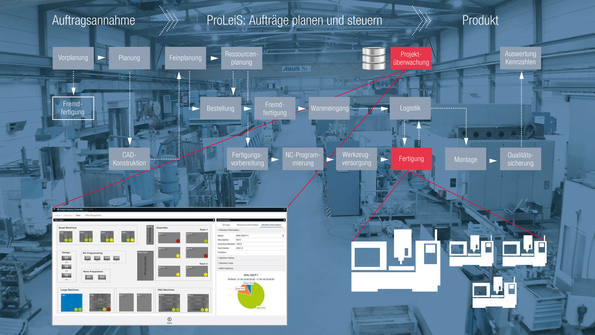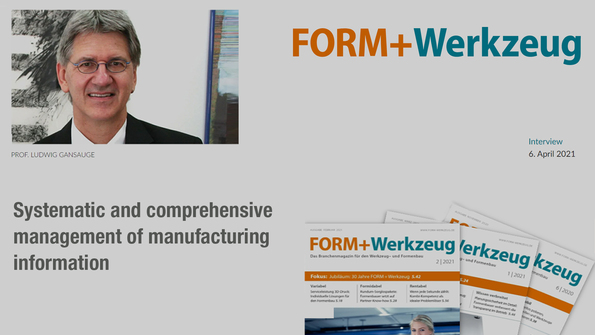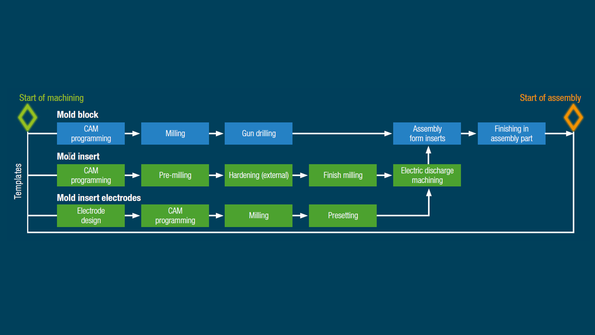Are your manufacturing data in the digital flow yet?
→ What is a holistic process approach?
→ Why does it pay to organize the flow of data in your company?
→ What exactly happens in digital assignment?
→ How do other die manufacturing companies meet the challenge?
Is all your manufacturing information already in the digital flow, or are you still collecting it manually? The truth probably lies somewhere in between. I recently read an interview that I highly recommend on the intelligent data flow in one-off production and why it’s so important. I found the interview with Prof. Gansauge (Deggendorf Institute of Technology) so interesting that it inspired my blog article. I’ve also read a report from one of our customers who’s taken on this challenge as a case example.
In the past, the fine-tuned gut feeling of experienced employees often proved to be a critical advantage in manufacturing. However, today decisions can be made based on information in the form of numbers and facts from manufacturing. This information can be weighed, it can be verified and others can understand it precisely. Prerequisite: a seamless, digital and extremely efficient flow of information throughout the entire company.
Holistic process approach in die and mold manufacturing
Many surveys show that digitalization is considered important for industry. Despite this, the digital transformation is confronted with special challenges in the highly complex environment of industrial one-off production. There’s tension between the multi-faceted technical challenges involving the potentially complex interrelationships of one-off production on the one hand, and the most cost-effective solution is the optimal implementation on the other. In my opinion, both sides can be harmonized by taking a holistic process approach and using digitalized manufacturing information.
I like to explain the holistic process approach as a "central nervous system" similar to that in humans. It collects, distributes and processes large quantities of information. But each part of the body from head to toe only receives the information that’s important for it.
From my perspective as a product manager, I then discuss digital manufacturing management, which encompasses the entire process at die manufacturing companies and other one-off manufacturers. For this form of management, we need to digitally interconnect individual processes to form a holistic system. This includes the digitalization and connection of information from manufacturing and the integration of information from adjacent processes (planning, logistics) and departments (purchasing, management).
Networking the information flow in particular creates new connections in die manufacturing companies. This results in valuable opportunities to coordinate more efficiently with each company area and to create data-based business models. Our ProLeiS MES is a central nervous system for one-off production. As an open integration platform, our software solution draws on a broad spectrum of manufacturing information and provides relevant digital data in all directions in real time. The ProLeiS plus: The MES also enables the digital planning, management and evaluation of die manufacturing processes. Independent of ProLeis, I recommend the following interview on this subject from the technical press.
Important information on the digital flow of information
In the "Industry 4.0 Applications Laboratory" at the Deggendorf Institute of Technology, Prof. Ludwig Gansauge is working on projects that include automation solutions for the CAD/CAM/CAQ process chain in die and mold manufacturing.
Theory meets practice: In the interview, Professor Ludwig Gansauge at the Deggendorf University of Technology clearly explains why it’s worthwhile for the industry to more carefully examine the data flow throughout the entire company. And in addition, to structure and comprehensively digitalize it. Take a look:
Systematic and comprehensive management of manufacturing information
Efficient and isolated solutions – no connection
It becomes clear in this interview with the industry press that many individual processes in die manufacturing are often already very well developed technically. For example, there are many good solutions in costing and planning – from parametric design to automated NC programming and assembly – that when viewed individually yield good results and tangible effects in terms of efficiency, speed and flexibility. Unfortunately – and this is precisely my view – they’re rarely coordinated or consistently linked together. The flow of information grinds to halt. As a ProLeiS product manager, however, I focus on intelligent connections that form a holistic system.
A specific example: Each employee is responsible for their own area and ensures good utilization of their own machines: So far, so good. Finally, all the parts come together in assembly some earlier, some later, and for a variety of reasons that aren’t always communicated. Gaps like this in the flow of information have negative impacts: While key parts for assembly are still missing, others are blocking the way and increase downtime. This doesn’t have to be the case.
We address precisely these issues with ProLeiS. A die manufacturing company can correct these and similar weaknesses by taking a holistic process approach. End-to-end communication, for example, from manufacturing or assembly sequences across the entire production chain, enables better coordination and greater transparency right from the start. This is a perfect task for a central nervous system like ProLeiS, which we combine with our die manufacturing customers' requirements. Just like in this practical example from our customer Koller Formenbau GmbH.
Benefits of digital connection
Manufacturing overview
Any company that wants to make reliable statements about deadlines, availability and prices has to have their numbers, data and facts up to date. Our customer follows this practical approach and discusses it in their report.
"Whether it's a deadline change, a last-minute order or the failure of a machine: Just a few mouse clicks in the system gives us a transparent overview and we can give the customer a clear answer.”
Read more in the complete success story. Download the pdf here: Koller Formenbau enjoys reliable and transparent planning in ProLeiS
From a broad perspective, I’d like to encourage you to give some thought to the digital knowledge transfer and how to preserve expertise in your company. My next blog entry will cover how you can intelligently digitalize your manufacturing information. I'm currently evaluating results, tips and many ideas that we and our customers find valuable.
Download the success story here: Koller Formenbau enjoys reliable and transparent planning in ProLeiS
Our author:






